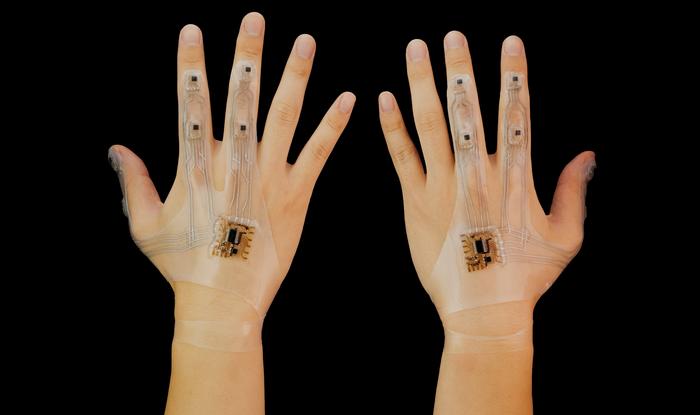Stretchable, wearable devices that can sense physical and bioelectrical information quickly and accurately are increasingly being used for things like health monitoring and motion measurement. However, making a device that is stretchy enough to be comfortable and rigid enough to accurately sense data is difficult.

Credit: Yokohama National University
Stretchable, wearable devices that can sense physical and bioelectrical information quickly and accurately are increasingly being used for things like health monitoring and motion measurement. However, making a device that is stretchy enough to be comfortable and rigid enough to accurately sense data is difficult.
Machine learning can help make these devices more powerful, but in order to integrate the technology, stretchable hybrid wearables that combine comfort and stable data processing will need to be developed.
A paper published in Device on August 7 outlines how rigid integrated circuits layered on a flexible substrate can be used to improve wearable performance.
“Stretchable devices combining high-performance sensor integrated circuits based on solid-state electronics have been developed, but they lack the stretchability to accommodate large deformations of more than two times elongation. These factors have limited the development of integrated systems for stretchable devices and machine learning,” said Hiroki Ota, associate professor in the Faculty of Engineering at Yokohama National University. In fact, Ota explained, there are no devices currently available on the market that can measure with both high accuracy and high repeatability among stretchable devices (or devices that have high deformability).
In this study, researchers focused on developing motion capture wearables with integrated machine learning. The devices were very deformable, meaning they were flexible and could contour to the body. Structures called heterogeneous-rigidity protective structures were developed to provide the extra stability to the flexible wearables. These structures protected the electrical wiring and had three layers: a hard layer, an intermediate layer, and a soft layer. The soft layer ensured the device remained stretchy and the harder layers maintained the integrity of the sensors in the device. Liquid metal paste was also used throughout the device, including to develop the wiring, to ensure the device remained flexible.
“The fusion of stretchable materials and solid-state electronics-based rigid elements realizes novel devices that combine elasticity with high computing and measurement capabilities. These devices promote integration with machine learning systems, where data reproducibility is critical,” said Ota. To test the power of the wearable device, researchers performed three tasks: self-shape estimation of knots, recognizing writing in the air, and sign-language recognition. Researchers also tested how well the device continued to work as it was stretched.
When compared to previous iterations of wearable devices that only have a circuit board, the newly developed device with the heterogeneous-rigidity protective structure was better at handling elongation and stretching. The device with only the circuit board and soft layer showed strain at 30% elongation and it broke at 100% elongation. In comparison, at 100% elongation the device with the heterogeneous-rigidity protective structure did not show any signs of damaging strain and it continued to work even if stretched to 150%.
The devices were also tested to see how well they performed at certain assigned tasks, including recognizing the letters spelled during finger spelling and sign-language recognition. Currently, wearable devices used to track finger spelling have difficulty with parallel movements without finger bending. The newly developed heterogeneous-rigidity device was able to accurately classify between 91% and 98% of the letters spelled, depending on the processing model used to analyze the data, but additional research is needed to understand differences in the training models.
Researchers also posited that the technology could go beyond finger spelling and recognize American Sign Language, a highly sought-after technology. The challenges for developing this technology, however, go beyond the limitations of stretchable, wearable devices and additional development is needed.
Looking ahead, researchers plan to develop more devices with this new technology. “Ultimately, we aim to realize stretchable hybrid electronics that integrate solid-state and stretchable electronics by utilizing the electronic properties of both rigid devices and elastic materials, and by integrating them with information processing technology,” said Ota.
###
Yokohama National University (YNU or Yokokoku) is a Japanese national university founded in 1949. YNU provides students with a practical education utilizing the wide expertise of its faculty and facilitates engagement with the global community. YNU’s strength in the academic research of practical application sciences leads to high-impact publications and contributes to international scientific research and the global society. For more information, please see:
Journal
Device
Article Title
Soft intelligent systems based on stretchable hybrid devices integrated with machine learning
Article Publication Date
7-Aug-2024



